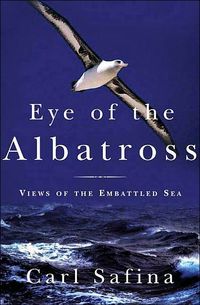Reviewed by Grant McCreary on February 2nd, 2008.
The foundation of this book is an individual female Laysan Albatross and her experiences over one breeding season. Based upon this premise, I’d be willing to wager that most of you have doubts about this book. You may have yet to set eyes upon the regal form of an albatross, effortlessly skimming the ocean’s waves. You may never have even participated in a pelagic trip. Thus, how interesting or relevant could such a story be? And how could the author fill up a (not thin) book with this tale? I had the same concerns, even though seabirds fascinate me. Trust me – any apprehension is completely unwarranted.
The book begins with the author traveling to one of the small northwestern Hawaiian Islands. There he joins a team of biologists studying Laysan and Black-footed Albatrosses. At that time, there was a little anecdotal and experimental evidence of these large seabirds’ ocean-wandering capabilities. But no one knew for sure where they went on their many fishing trips to procure food for their chicks. Now technology had progressed enough to allow tracking devices small enough to be attached to these birds. Satellites could then precisely track their journeys. These species are declining at an alarming rate, and this information is vital in conservation efforts.
The author named one of the tagged Laysan Albatrosses Amelia. The narrative follows her struggles to raise her single chick – from egg to helpless chick to independent fledgling. Safina was able to personally observe Amelia, her mate, and her chick while they were on the island. But the tale also continues while she was away. Thanks to the tracking device, he knew precisely where she was at all times, but not exactly what she was doing. But he filled in these gaps based upon collective knowledge of the species and his own personal observations of the birds. Thus, as the author states in the preface, Amelia’s experiences away from the island that are told here are generalizations.
In addition to this specific storyline, the author also widens the focus to include information about the Laysan species and albatross family as a whole. These are utterly fascinating creatures, and the reader will learn a great deal about them in the course of this tale. For instance, albatross mate for life. Thus, the death of a mate may cost the survivor one to four breeding cycles since they will have to undergo another extensive courtship, which can take several years. This is yet another reason that adult mortality at the hands of man is such a great danger to these long-lived birds.
But that’s not all. The author also takes us on several side-trips across the Pacific. These include tracking Tiger Sharks, tagging Green Sea Turtles, and joining up with an Alaskan fishing boat. Some of these don’t have any direct relation to the book’s titular subject. However, as Safina makes perfectly clear, all are indeed connected. And all of the subjects here – from birds to fish, biologists to fishermen – are exceptionally enthralling and educating.
This is perhaps the best-written book that I have ever read. The language the author uses is florid, evocative, and poetic, but also accurate and so descriptive that it does not take much effort to place yourself in the scene he is describing. Here’s just one example:
Look up at these dark frigatebirds, their forked tails streaming, their long crooked wings recurved. Flying crossbows, they evince a grace most sinister.
He completely captures the essence of these birds, as he does with every other creature and event that he describes.
This is a good thing most of the time. But Safina doesn’t shrink back from recounting the horrors that man has inflicted on these species, and they are truly heartbreaking. Still, they need to be told. We need to know what has been, and is currently being, done to harm them so that it can be stopped and never repeated.
Everyone – birders and non-birders alike – should read this book. It’s educational, entertaining, and simply a superb read. I know that if I’m ever fortunate enough to see another albatross, I will not look at it in the same way.
Disclosure: I get a small commission for purchases made through links in this post.



I agree with your review. A wonderful book. I read it about two years ago and it was really hard to put it down.
Thanks Markus!
I’m currently reading the author’s Voyage of the Turtle, and it’s also great. Man, that dude can write!
Love the book. It really had an awesome story line to it. Appreciate the review. Cheers